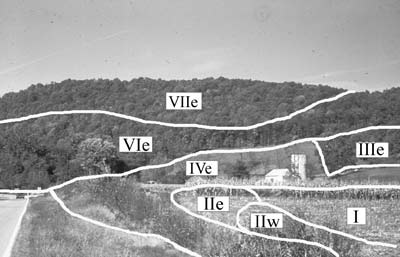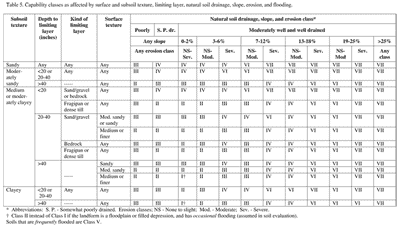III. SOILS, AGRICULTURE, AND ENVIRONMENT
Capability Classes Next Section>>
This section provides an overview of the potential of the soil for crop production. It discusses land capability class and subclass, and whether or not the soil qualifies as prime farmland.
Subsections:Land Capability Class | Land Capability Subclass | Prime Farmland
Land capability classification shows, in a general way, the suitability of soils for most kinds of field crops. Several classes are shown in the photograph, Fig. 20. In the capability classification system, soils are grouped at two levels: capability class and capability subclass.
Capability classes, the broadest groups, are designated by Roman numerals I through VIII. The numerals indicate progressively greater limitations and narrower choices for practical use. The classes are defined as follows:
• Class I soils have few limitations that restrict their use.
• Class II soils have moderate limitations that reduce the choice of plants or that require moderate conservation practices.
• Class III soils have severe limitations that reduce the choice of plants and/or that require special conservation practices.
• Class IV soils have very severe limitations that reduce the choice of plants and/or that require very careful management.
• Class V soils are not likely to erode, but have other limitations such as frequent flooding that limit their use.
• Class VI soils have severe limitations that make them generally unsuitable for cultivation.
• Class VII soils have very severe limitations that make them unsuitable for cultivation.
• Class VIII soils and miscellaneous areas have even more severe limitations.
Seven soil properties from the score card are entered into Table 5 to determine land capability class. They are: flooding or ponding hazard (derived from the landform), texture of subsoil, depth and kind of limiting layer, surface texture, drainage, slope, and erosion.

Fig 20. A landscape in southern Indiana showing several land capability classes and subclasses.
Table 5. (Click for Larger View) Capability classes as affected by surface and subsoil texture, limiting layer, natural soil drainage, slope, erosion, and flooding.
For soil evaluation, first assume that soils on floodplains or in filled depressions have an occasional flood hazard and can be no better than Class II. This is explained in the note at the bottom of Table 5. (Soils with a frequent flood hazard are Class V, but are not considered in soil evaluation). Then, determine the applicable combination of subsoil texture, depth and kind of limiting layer, and surface texture in the left side of the table to find the correct row. Finally, determine the proper combination of drainage, slope, and then erosion on the top of the table to find the correct column. The intersection of the correct row and the correct column gives the land capability class.
back to topLand Capability Subclass
Land capability subclass shows the reason or reasons a soil is not Class I land. It might have erosion (e) or wetness (w) problems, or the soil may be shallow or droughty (s). Class I soils have no capability subclasses because they have no severe limitations for crop production. The letter “e” shows that the main limitation is risk of erosion unless close-growing plant cover or heavy plant residue cover is maintained. The letter “w” shows that water in or on the soil interferes with plant growth or cultivation. In many soils the wetness can be partly corrected by artificial drainage. The letter “s” shows that the soil is limited mainly because it is shallow, droughty, or stony. For soil evaluation, Class II through VIII soils have one or more subclasses.
back to topPrime Farmland
In recent years, many people have become concerned about the loss of excellent farmland to nonagricultural uses such as highways, urban sprawl, apartments, shopping centers, industrial areas, and surface mines. To help local governments preserve these soils for continued food production, the U.S. Government recognizes prime farmland as land capable of producing good yields of adapted crops in most years. It is defined in terms of soil properties, many of which are determined in soil evaluation. Many Indiana soils qualify as prime farmland. This concept is now being considered by many planning units at local, state, and federal levels as a guide for identifying land which should remain agricultural rather than be used for urban development.
Excluded from the designation of prime farmland are soils that frequently flood, have low water-holding capacity (sandy, or shallow to some limiting layers), or are very erodible (usually on slopes steeper than 6%).
To preserve agricultural land, state law now requires that coal companies must return mined land to its original productivity if it was prime farmland before it was mined.
Soil Evaluation Rules - Capability Classes
| Use Table 5 to determine Land Capability Class. |
Determine Land Capability Subclass 1. slope of 3% or more, or Mark SUBCLASS 1. 40 inches or less to any limiting layer, or Mark SUBCLASS 1. poorly or somewhat poorly drained, or |
Mark Prime Farmland 1. moderately sandy or finer subsoil texture, and |
back to top

